Exploring the UCSD Surfing Class: A Comprehensive Overview
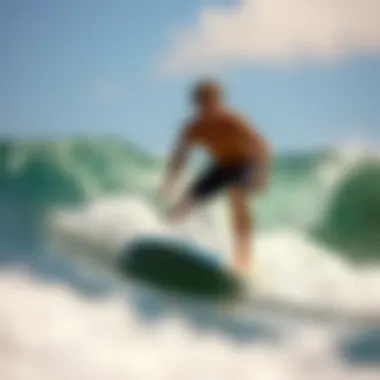
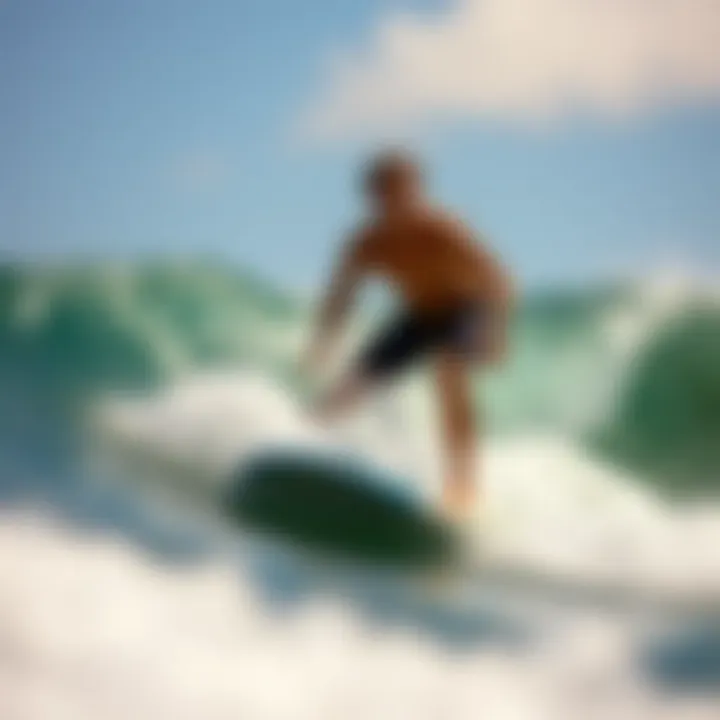
Intro
The allure of the ocean can make anyone feel at home, and for students at the University of California, San Diego, this feeling comes packed with an opportunity to learn the art of surfing in a structured setting. The surfing class offered at UCSD is much more than just riding waves; it represents a deeper integration of physical education into the vibrant surf culture that surrounds the Southern California coastline. For both novices and seasoned surfers, understanding the class structure, equipment used, and the techniques taught reveals just how significant this program is for enriching student life.
UCSD's commitment to outdoor education takes shape through its surfing curriculum, benefiting not only students’ physical fitness but also their mental well-being and community ties. Embracing the experience of riding waves fosters a sense of belonging while promoting a healthy lifestyle. Nonetheless, before one can paddle out, familiarization with the necessary gear and equipment forms the backbone of any fruitful surfing experience.
Gear and Equipment
When it comes to surfing, having the right gear is essential. UCSD equips its students with knowledge about the latest technologies in surfboards and necessary accessories to enhance their surfing journey.
Latest Surfboard Technologies
Surfboard innovation has come leaps and bounds in the last few years. Materials such as epoxy resins and lightweight foam have become popular, delivering enhanced buoyancy and flexibility. Some surfboards even incorporate advanced design features, like channels that can help with speed and maneuverability.
Additionally, smaller brands are emerging with eco-friendly alternatives that utilize sustainable materials. For instance, surfboards made from recycled foam not only perform well but also reduce environmental impact. Understanding these advancements provides students with a solid foundation for making informed choices about their surfing craft.
Essential Accessories for Every Surfer
Regardless of skill level, certain accessories are a must-have for anyone serious about hitting the waves. Essential tools include:
- Wetsuits: Designed to insulate and protect, wetsuits vary in thickness depending on water temperature. They allow surfers to stay warm while minimizing the risk of hypothermia.
- Leashes: Often overlooked but critically important, leashes prevent surfers from losing their boards during wipeouts, which can be a safety hazard for others.
- Wax: Regular application of surf wax improves grip on the board, minimizing slippage when paddling or executing turns.
- Surfboard Bag: This provides essential protection during transportation, helping to maintain the integrity of the board.
With these items in hand, students at UCSD can step out onto the sand with confidence as they prepare for their first wave.
Surf Techniques and Skills
Each participant in the surfing class at UCSD is guided through a curriculum designed to foster skill development. Whether starting from scratch or refining existing techniques, this class covers a broad range of skills necessary to surf effectively.
Beginner Surfing Techniques
For those just starting out, the class introduces fundamental techniques that form the building blocks of surfing. Students learn:
- Paddling: This is the essential movement that propels surfers toward waves. Proper technique reduces fatigue and enhances performance on the water.
- Pop-up: The moment a surfer transitions from laying on the board to standing, called the pop-up, is crucial. This move, practiced repeatedly, helps students establish good balance and stability.
- Wave Selection: Not all waves are created equal. Understanding which waves to choose can significantly impact one’s surfing success.
Advanced Maneuvers for Experienced Surfers
For those with prior experience, UCSD’s class further develops surf skills through advanced techniques such as:
- Cutbacks: A maneuver that involves turning back toward the breaking part of the wave. It’s all about maintaining speed while changing direction.
- Floater: Riding over the top of the breaking wave provides a thrilling experience and showcases confidence.
- Aerials: While these may not be for everyone, learning to launch off the wave into the air adds an exciting element to surfing.
"Surfing can be an exhilarating sport but it also demands respect for the ocean and its surroundings. Understanding these skills fosters not just better surfers, but better stewards of our coastal environment."
In summary, the surfing class at UCSD offers a rich and multifaceted experience. From essential equipment to a comprehensive curriculum that caters to varied skill levels, this program stands out as a testament to the university’s commitment to holistic education and community engagement.
Intro to UCSD Surfing Class
The culture of surfing runs deep along the coasts of California, particularly in places like San Diego where waves and sandy shores beckon enthusiasts from all walks of life. Within this vibrant context lies the surfing class at the University of California, San Diego (UCSD), which is not merely about standing on a board and riding waves; it’s an enrichment of the mind, body, and spirit. This section explores why such classes hold immense importance, not only for the participants but also for the institution itself.
Overview of Surf Classes at Institutions
When considering surf classes, many might envision a laid-back atmosphere with instructors casually offering tips, sipping coconut water on the beach. However, the reality is much more nuanced. Various educational institutions across the globe have caught on to the benefits of incorporating surfing as part of their programs, bringing a unique dimension to physical education.
At many universities, courses are tailored to cater to different skill levels, from complete novices dipping their toes into the ocean for the first time to experienced surfers looking to refine their techniques. Typically, these classes encompass not only the fundamentals of paddling and popping up but also delve into surf history, oceanography, and environmental stewardship. The institutions provide structured learning that aims to create well-rounded surfers physically, mentally, and socially.
The Unique Position of UCSD
What makes UCSD’s surfing class particularly distinct in this vast sea of offerings? For starters, its prime location along the picturesque La Jolla coastline allows students unprecedented access to some of California's most consistent surf breaks. This geographical advantage is coupled with a dedicated pedagogy focused on mindful surfing and ocean conservation.
Beyond the typical focus on skill development, UCSD integrates academic principles with surfing culture. Students are encouraged to engage in community-driven projects and surf-related research, fostering an immersive experience that goes beyond the classroom. For instance, surf science courses studied in combination with ocean dynamics can lead to a deeper appreciation for the ocean environment, equipping learners with the knowledge and skills needed to become informed surfers and conscientious ocean stewards.
Moreover, the culture of UCSD embraces inclusivity, welcoming surfers from all backgrounds and skill levels to participate. Instruments of encouragement and support flourish in this environment, painting the picture of a vibrant, united surfing community. Students note, "The surfing class is not just about riding waves; it’s like finding my tribe. Everyone is cheering for each other, and that’s something special."
This unique combination of environmental awareness, community integration, and academic rigor does not just create surfers; it cultivates responsible ocean advocates equipped to enjoy and protect this beloved setting.
In summary, UCSD's surfing class is not solely an athletic endeavor; it is an avenue to explore personal growth, environmental appreciation, and community building.
Through this introduction, readers can appreciate how surf courses at UCSD merge physical skill, cultural insight, and environmental responsibility, making participation a much richer experience than mere sport. The following sections will delve deeper into the specific components that comprise this course, offering a detailed look at the curriculum structure and teaching methodologies.
Curriculum Structure
The curriculum structure of the surfing class at UCSD is not just a malleable framework; it’s the backbone of learning how to ride the waves. This structure encompasses fundamental aspects that cater to surfers of various skill levels, ensuring that everyone leaves with not just an understanding of surfing but also a genuine love for the ocean. A well-structured curriculum also emphasizes safety, ocean knowledge, and personal growth, making it a holistic educational experience rather than just a series of lessons.
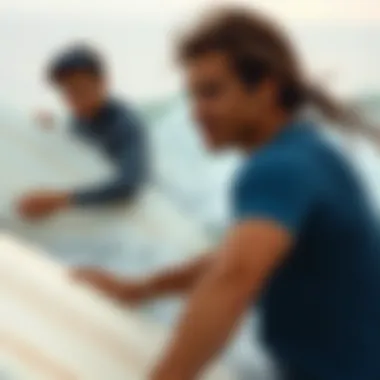
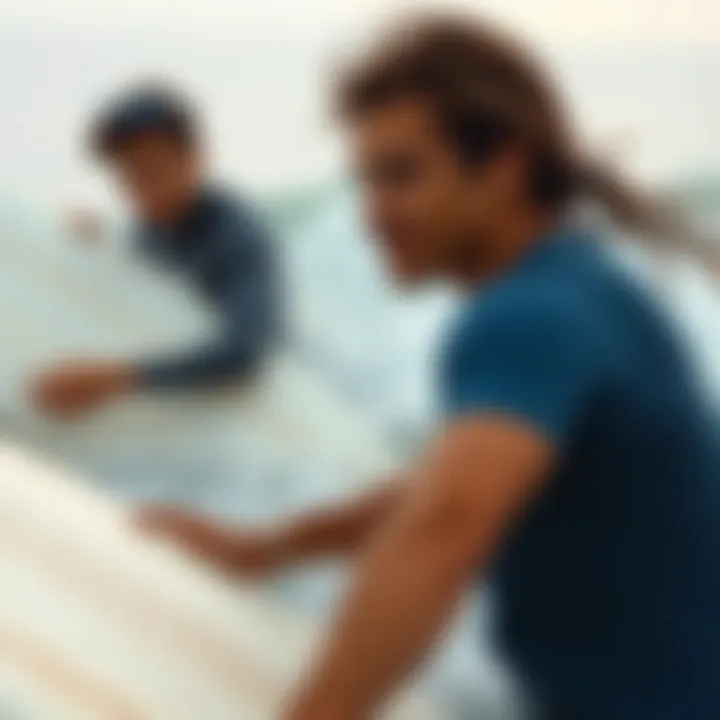
Basic Surfing Techniques
In any surfing class, the foundation is built on basic techniques. From paddling techniques, where students learn proper position on the board, to the vital skill of popping up to a standing position, these essentials are taught with precision.
Several techniques are emphasized here:
- Paddling: Students are taught how to position their hands and body while paddling through waves, which is crucial for catching waves effectively.
- Balance: Finding that sweet spot on the board is an art; instructors provide personalized feedback to help students improve their balance over time.
- Positioning for a Wave: A significant challenge that all beginners face is knowing when and where to position themselves to catch the wave – a moment of thrill when executed right.
These basics aren’t just mechanical; students feel the rhythm of the ocean while practicing, building muscle memory. Also, having a solid grasp of these fundamentals leads to greater confidence, necessary for tackling the next hurdles in surfing.
Advanced Maneuvers and Skills
As students become more comfortable on a board, advanced skills come into play. UCSD recognizes that mastering these maneuvers elevates a surfer's ability, transforming them from a novice to someone who can truly dance with the waves.
This includes:
- Cutbacks: A maneuver where surfers redirect their board back toward the breaking portion of the wave, showcasing skill and strategy.
- Aerials: While challenging, students are given a glimpse into aerial maneuvers, where they learn to leave the wave while maintaining control.
- Bottom Turns: Essential for setting up a ride, this maneuver is intricately tied to speed and control, allowing surfers to exploit the wave’s energy.
These advanced techniques are not just flamboyant displays; they reflect a surfer's understanding of wave mechanics, board dynamics, and personal style. They shape the identity of a surfer, making progression not just about skills but self-expression.
Ocean Awareness and Safety Procedures
Beyond techniques and skills, UCSD's surfing program places a strong emphasis on ocean awareness and safety. Students must understand the ocean's temperament, tides, and currents to navigate safely. Their training involves:
- Learning about Tides: The area’s tides can significantly alter conditions; understanding how tides work is essential for safety and success.
- Identifying Hazards: Students are taught to spot dangers like riptides and rocky areas. Knowing what to avoid ensures safer surfing experiences.
- Equipment Usage: Proper usage and maintenance of surfboards and safety gear are discussed. It's crucial to know one's equipment inside and out to avoid mishaps.
"Safety isn't just taught; it's ingrained into every aspect of surfing education. Understanding the ocean is as crucial as riding the waves.”
In essence, the curriculum structure is designed to guide students from the first splash into the ocean, all the way to daring tricks and maneuvers. Every wave caught, every tumble taken is a testament to the well-rounded approach embedded in UCSD's surfing class.
For more information about surf safety and ocean awareness, you can check out resources like surflifesaving.org.au or saveourbeaches.org, both of which emphasize the importance of education in beach safety.
Teaching Methodologies
Teaching methodologies in the UCSD surfing class are pivotal, shaping both the learning experience and outcomes for students. The blend of hands-on experiences, the integration of advanced technology, and the connection between theory and practice serves to enrich the educational environment. In a sport as dynamic as surfing, the right methodologies can make a significant difference, aiding students in navigating not just the waves, but the myriad of skills they need to acquire.
Hands-On Learning Experiences
In the realm of surfing, nothing quite trumps the power of hands-on learning. UCSD’s surfing class prioritizes practical sessions in the water, which is arguably where each lesson truly comes to life. This approach means students aren’t merely reading about surf techniques; they’re out there experiencing them firsthand.
Imagine standing on the shore watching the tutors demonstrate paddling techniques, wading into the surf, and feeling the sea spray on your face. This is where theory transforms into action. Each class typically involves a balance of instruction on land and actual surfing time, so participants can immediately apply what they have learned.
- Learning by Doing: This method encourages the uptake of skills through direct experience allowing students to internalize movements.
- Addressing Individual Needs: Instructors can provide immediate feedback tailored to each student's performance, fostering personal growth and confidence.
The ability to practice in varied wave conditions equips students to adapt and thrive in different surfing scenarios, making them more versatile surfers.
Use of Technology in Surf Education
Modern surfing education is not just about catching waves; it’s also leveraging cutting-edge technology to enhance learning. At UCSD, instructors incorporate various technologies that streamline and enrich the educational process. For example, video analysis units where surfers can review footage of their performance allow them to see their strengths and areas requiring improvement.
Additionally, surf forecasting apps play a crucial role in teaching students about marine conditions. Understanding tides, swells, and wind patterns can greatly influence a surfer’s performance. Here are some of the technological tools used:
- Drone Footage: Captures real-time footage of surfers in action, providing a perspective that aids in skill assessment.
- Wearable Devices: Track performance metrics like wave count, distance paddled, and time spent in the water.
- Interactive Courses: Online modules complement in-water training, covering topics from ocean safety to surfboard etiquette.
This technology not only bolsters training effectiveness but also engages students by merging their surfing passion with innovative tools.
Integration of Theory and Practice
A balanced integration of theory and practice is vital in any educational framework. Here, it ensures that surfers understand not just how to ride a wave, but why specific techniques work. During discussions, instructors delve into the science behind wave mechanics and environmental factors affecting surfers. This academic angle creates a well-rounded knowledge base.
Moreover, students learn about the history of surfing, the cultural implications, and environmental stewardship. For instance, discussing the impact of climate change on surf breaks enriches their perspective as surfers and ocean users.
- Structured Lessons: Each class blends lessons that take place on land with practical sessions on the water, reinforcing the concepts discussed.
- Engagement in Community Issues: Students are encouraged to participate in local conservation efforts, fostering a connection with the surf community and raising their awareness about ocean health.
This thoughtful integration creates capable surfers equipped not only with physical skills but also a strong understanding of their environment.
"Surfing is not just a sport; it's a way to connect deeply with the ocean, the community, and oneself."
Overall, UCSD's teaching methodologies provide a unique blend of hands-on involvement, technological engagement, and theoretical grounding. This synthesis not only prepares students for surfing but instills a deeper appreciation for the culture and environment surrounding them.
Participants and Skill Levels
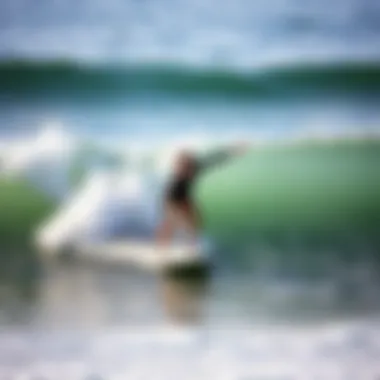
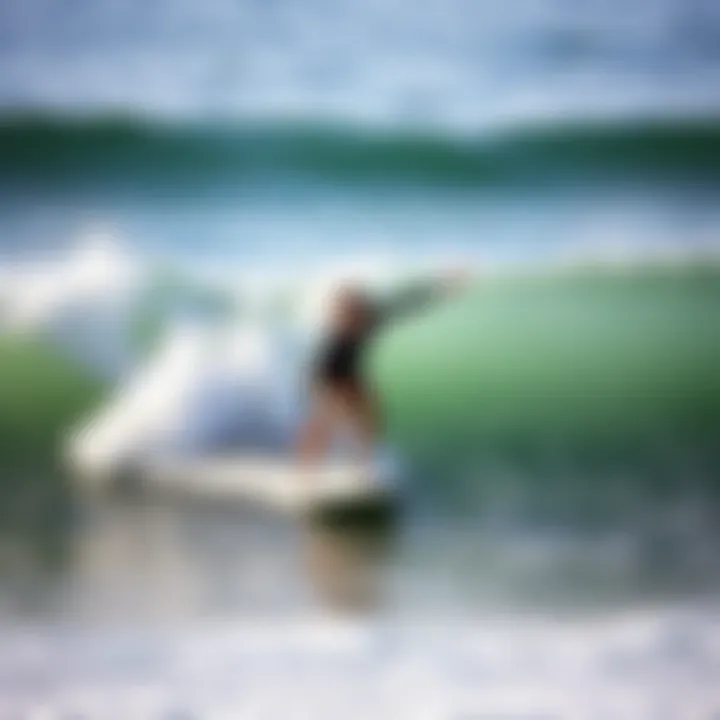
Understanding the different participants and their respective skill levels in the UCSD surfing class is key for grasping the overall structure and goals of the program. The setup accommodates a spectrum of abilities, fostering an environment where everyone, from novices to seasoned surfers, can progress at their own pace. It's not just about riding the waves; it's about building confidence, learning essential skills, and developing a deeper appreciation for the ocean and its environment.
Beginner Surfers and Their Journey
For beginners, the journey into surfing can feel like stepping into a whole new world. The very first lessons are tailored to ensure that new surfers are not overwhelmed. They often start with understanding the basics — things like paddling, balancing on the board, and catching small waves. This foundational knowledge builds a crucial safety net that encourages them to explore further.
Beginner classes are designed to be approachable and supportive. An emphasis is placed on creating a safe space where learners can ask questions and share their fears, helping to ease into what can seem like a daunting sport. Potential surfers learn about important safety measures, including recognizing rip currents and understanding surf etiquette. In short, the goal is to not just stand on a board but to build a bond with the sea.
"Each wave is a new lesson, each wipeout a stepping stone." - Surf Instructor
Intermediate to Advanced Pathways
Once surfers gain some experience, they often transition into intermediate or advanced sessions, where the focus shifts to refining techniques and mastering more complex maneuvers. For instance, surfers might learn how to perform critical turns, aerials, or even how to navigate bigger waves. In these classes, personalized instruction plays a significant role; lesson plans adapt according to each student’s ability and progress.
Surfers at this level also start to explore their surfing style, which allows them to express individuality on the water. Additionally, understanding how to read ocean conditions becomes critical. Spotting swells, understanding how tides impact surf breaks, and knowing the best time of day to catch waves are all part of this progression. Advanced students are often encouraged to start participating in local competitions, a step that introduces them to the competitive aspect of surfing and community building.
Community and Surf Culture Interaction
The connection between the UCSD surfing class and the broader surf culture cannot be overstated. As surfers spend time together in the water, they form bonds that go beyond simply learning to surf. Community becomes a central element. They participate in surf clean-up days, local competitions, and social events, forging relationships that often last beyond their time in the class.
Joining a community of surfers fosters a sense of belonging, making the act of surfing not just a sport but a lifestyle. This interaction helps them appreciate the local environment, emphasizing respect for the ocean and marine life. Students learn about sustainable practices that protect their local surf spots, making the program not only about personal gain but also about collective responsibility.
In sum, the UCSD surfing class not only develops individual skills but also nurtures a supportive community, laying the groundwork for lifelong relationships and a deeper commitment to the surf culture.
The Role of Equipment in Learning
When it comes to surfing, the right equipment isn't just a nice-to-have; it’s a game changer. The tools and gear that surfers use have a direct impact on their learning experience and performance on the waves. Understanding the equipment is fundamental to grasping how the instructional content at UCSD’s surfing class is designed to develop skills and foster a passion for the sport. From the surfboard to the wetsuit, every piece of gear plays a crucial role in shaping a surfer’s ability and safety.
Essential Surf Gear
First off, let's take a look at the essential gear that supports the surfing experience. Each component is carefully chosen based on activity, skill level, and environmental conditions. Key items include:
- Surfboard: This is the centerpiece. The size, shape, and material influence maneuverability and stability.
- Wetsuit: Vital for thermal comfort and protection against the cold waters of the Pacific. It aids in maintaining body temperature.
- Leash: This accessory attaches the surfer to the board, preventing the board from floating away after a wipeout. It's crucial for safety, both for the surfer and those nearby.
- Surf Wax: This simple yet effective product provides grip on the board, preventing slipping, especially crucial for beginners learning to balance.
- Sunscreen: Protecting the skin from UV rays is often overlooked but essential for extended surf sessions under the sun.
Having quality gear tailored to individual needs ensures a smoother learning process. Without the right tools, every tumble in the water may turn into an exercise in frustration rather than learning and enjoyment.
Choosing the Right Surfboard
Selecting the right surfboard is akin to choosing the right tool for any job. It’s not about going for the flashiest model; it’s about the fit. For beginners, a longer, wider board offers stability and makes catching waves easier. These boards are generally thicker and allow new surfers to stand up without too much struggle. As surfers progress, they may opt for shorter boards to enhance maneuverability and tricks. Factors to consider include:
- Length and Width: Longer boards provide more stability; shorter ones allow for sharper turns.
- Material Type: Foam boards float better and are ideal for novices, while fiberglass boards are preferred for advanced surfers given their durability.
- Tail Shape: This influences how the board performs in different conditions, such as small waves versus more powerful swells.
The ongoing conversation between surfers about gear often leads to heated debates. Each individual's experience shapes their preferences, making it a communal exploration of individuality while making waves.
Safety Gear and Its Importance
When discussing surfing, it’s easy to get caught up in the excitement of riding the waves. However, safety gear should never be an afterthought. Here’s where a well-rounded approach to surf outfitting comes into play:
- Helmets: While not common among all surfers, they are essential in certain surf conditions, particularly in reef breaks or during competitions.
- Impact Vests: These provide extra buoyancy and can help minimize injuries from falls or collisions. For those learning tricks in more aggressive surf, these vests are valuable.
- Personal Flotation Devices (PFDs): Particularly useful for less experienced surfers, they add an extra layer of security, especially in unfamiliar waters or adverse conditions.
Safety gear ensures that surfers can focus on their skills and learning without the looming worry of injury. By implementing these safety measures, UCSD’s surfing program not only emphasizes the adventure of sport but the significance of responsible surfing practices.
"The ocean can be both a friend and a formidable opponent; it's wise to know how to protect yourself while enjoying the ride."
Ultimately, having the right equipment isn't just a matter of convenience; it's about building confidence. When students know they are equipped to handle the surf, they can immerse themselves in the learning experience, making every wave an opportunity for growth.
In the heart of San Diego, where waves meet academia, understanding the role of equipment in learning provides surfers not only with skills but also with a deeper connection to their surfing journey.
Understanding the San Diego Coastal Environment
The coastal environment of San Diego is rich and multifaceted. For surfers, understanding this environment goes beyond just catching a wave; it is about becoming one with the ocean and its many moods. The unique elements of San Diego's coastline not only shape the surfing experience but also enrich the educational aspect of the surfing class offered at UCSD.
Surfing is inherently connected to its surroundings. Tides, winds, and swell patterns dictate surf conditions, affecting when and where surfers can ride waves. Moreover, local marine life introduces both an element of beauty and necessity for awareness in the water. This coastal environment isn't just a playground, it's a classroom that teaches respect, ecology, and the science of oceanography.
"The beauty of the ocean is only overshadowed by the responsibility we have to protect its ecosystems."
- Anonymous
Tides and Surf Conditions
One of the cornerstones of learning how to surf in San Diego involves understanding tides and surf conditions. The Pacific Ocean experiences distinct tidal shifts that can dramatically alter surf conditions from day to day. In general, these conditions can be categorized into various states such as high tide, low tide, and what surfers term as the tide's "slack" periods.
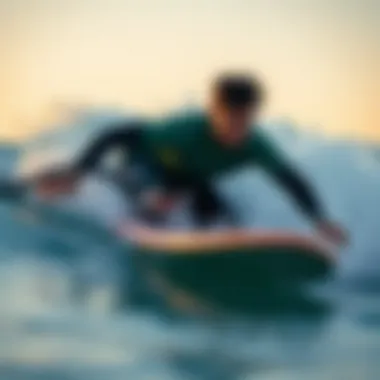
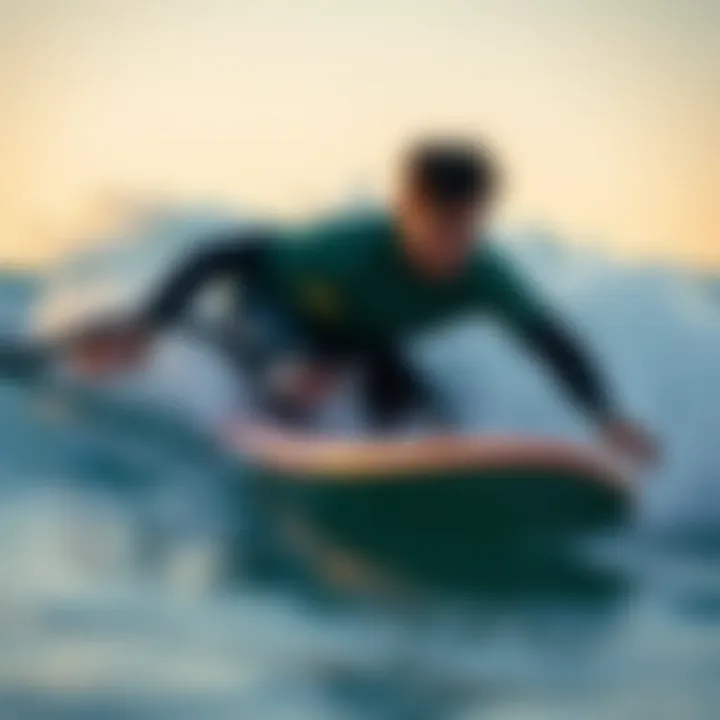
- High Tide: During this phase, waves tend to be less powerful in certain spots but can often bring smoother rides.
- Low Tide: Here, the exposed sandbars may create better conditions for surfing but at the cost of potentially more rocky areas.
- Slack Tide: This is when the tide is transitioning, often resulting in softer waves and a calmer ocean, which many beginners prefer.
Understanding these elements helps surfers gauge "when to go" versus "when to stay ashore." Every surfer needs to carry a keen awareness of these fluctuations, as conditions can shift in a heartbeat.
Local Marine Life Awareness
San Diego’s coastal waters teem with marine life ranging from playful sea lions to colorful schools of fish. For someone learning to surf, it’s crucial to develop an awareness of these creatures. Understanding the local marine ecosystem not only fosters a greater appreciation for nature but is also crucial for safety.
Common marine inhabitants include:
- Sea Lions: Often found resting on rocks, these creatures have a laid-back demeanor but can be territorial.
- Jellyfish: Their presence can vary, and swimmers need to watch out for them, especially in warmer months.
- Sharks: While often misunderstood, encounters are statistically low. Nonetheless, awareness contributes to ocean safety.
Familiarity with marine life correlates with good surfing practices. Students in the UCSD surfing class learn to recognize behavior patterns, which ultimately ensures safety as well as a deeper respect for the ocean.
Physical and Mental Benefits of Surfing
Surfing is not merely a hobby or a sport; it’s an avenue for enhancing both physical and mental health. For individuals enrolled in the UCSD surfing class, this connection is as significant as the waves they ride. Embracing the ocean, feeling the swells, and engaging with nature can lead to a myriad of mental and physical benefits that encourage a holistic lifestyle.
Enhancing Physical Fitness
Engaging in surfing provides a solid platform for physical improvement. This activity serves as a full-body workout, recruiting various muscle groups from your arms to your core to your legs. Paddling out, pop-ups, and maintaining balance on a board demands endurance as well as strength. What often goes unnoticed is the cardiovascular benefits attached to regular surfing sessions. By getting your heart rate up in the water, it is quite similar to participating in running or cycling.
"Surfing can torch calories like a bonfire, burning anywhere from 400 to 600 calories an hour depending on the intensity and duration."
Here are some of the essential components contributing to improved physical fitness through surfing:
- Strength Training: Paddling strengthens your arms, shoulders, and upper body. As you navigate waves, you regularly engage your core, which also enhances stability and balance.
- Flexibility: Surfing requires significant flexibility, improving mobility over time. The art of getting into the right position on your board stretches muscles and joints, helping avoid stiffness.
- Balance: Surfers constantly work on their balance, which can translate into better coordination in everyday life.
Beyond these physical gains, surfing can naturally integrate cardiovascular workouts, giving you an invigorating experience each time you hit the waves.
Mental Health and Stress Relief
On the psychological front, surfing stands out as a powerful tool for mental well-being. The rhythmic motion of the waves and being surrounded by nature can create meditative moments that ease anxiety and stress. For students at UCSD, whose academic pressures can often feel overwhelming, spending time in the ocean nurtures calmness and a sense of freedom.
Here’s how surfing contributes towards emotional resilience and mental balance:
- Mindfulness: Being in the water encourages mindfulness, as surfers focus intensely on the moment, the waves, and their movements. This fosters a deeper connection to the environment.
- Stress Reduction: The physical exertion of surfing can release endorphins, acting as a natural stress reliever and mood lifter. It’s akin to hitting the gym, but with more exhilarating scenery and sensations.
- Community and Connectivity: Surfing often fosters friendships and camaraderie, reducing feelings of isolation. The shared experiences create bonds that extend beyond the waves, thus enhancing one’s social support network.
In a nutshell, the physical and mental aspects of surfing are intricately connected. For UCSD surfers, learning to ride waves translates not just into fitness, but also encourages emotional health. The balance one finds on a surfboard can often be a reflection of balance in life, emphasizing the need for holistic wellness for every individual.
Participatory Events and Surfing Community Integration
Participatory events in surfing, particularly at UCSD, play a crucial role in enhancing the educational experience while fostering a sense of community among students and locals. These events create opportunities for individuals to bond over their shared passion for surfing, while also promoting relevant skills and safety practices necessary for navigating the waves. By bridging the gap between classroom learning and real-world applications, these initiatives enrich the entire surfing journey.
Surf Competitions and Exhibitions
Surf competitions and exhibitions are invaluable components of the UCSD surfing program. These events serve both as a showcase for talent and a platform for friendly rivalry. Students can test their skills against peers, gaining confidence and valuable feedback. Moreover, competitions often reflect the larger surfing culture, drawing participants and spectators from diverse backgrounds, which in turn cultivates a robust surfing community.
- Skill Development: Competing against others serves as a catalyst for personal improvement. Surfing under pressure sharpens techniques and enhances performance.
- Networking Opportunities: Engaging in these events allows students to connect with seasoned surfers, sponsors, and even industry professionals, potentially opening doors to internships and job opportunities.
- Community Engagement: These events foster camaraderie, uniting locals, students, and enthusiasts. Spectators can participate in various activities, making it a vibrant occasion rather than just a competition.
As one participant noted, "Competing at UCSD was more than just catching waves; it brought us together as a family of surfers, all supporting one another."
Volunteer Opportunities and Community Service
Volunteer opportunities within the surfing community further deepen the integration of UCSD students with San Diego's vibrant coastal culture. These programs often focus on environmental stewardship and promoting inclusiveness in the sport. In this respect, students are not merely consumers of the surf experience but active contributors to its sustainability.
- **Beach Cleanups: **Many organizations collaborate with local universities to host events focused on cleaning up beaches and preserving marine ecosystems. Students participate actively, understanding their impact on the environment while surfings.
- Surf Therapy Programs: Some initiatives work with less privileged families or those with disabilities, using surfing as a tool for therapy and empowerment. Students assisting in these programs gain unique insights into the therapy's benefits while sharing their love for surfing.
- Skill Shares and Community Workshops: Often organized by students, these workshops aim to teach basic surfing skills to local youth. By sharing knowledge and resources, students directly influence the community, promoting healthier lifestyles.
Culmination and Future Prospects
As we wrap up our exploration of the surfing class at UCSD, it's clear that this unique educational offering goes beyond just teaching the art of riding waves. The conclusion emphasizes not only the immediate benefits to students but also the long-term impact on their lives and the broader community. Surfing at UCSD embodies a blend of academic rigor and practical experience, merging the classroom with the oceanic world. It engages students physically, mentally, and socially, nurturing a well-rounded approach to education that is increasingly important in today’s fast-paced environment.
Evolving Surf Education Programs
Surf education isn't stagnant; it continuously evolves to meet the demands of new generations of surfers. UCSD's commitment to enhancing its surfing curriculum showcases innovative teaching methods and practices. Regularly updated programs integrate the latest in surfing technology and environmental awareness, ensuring that students are not only equipped with surfing skills but also have a strong grasp of ocean conservation.
This aspect of the programs serves a dual purpose:
- Skill Enhancement: Courses adapt to include changes in surf culture, new techniques, and community feedback on what’s working and what isn’t.
- Sustainability Education: Lessons are increasingly revolving around ocean health, marine ecosystems, and responsible surfing practices, contributing to a global consciousness among future surfers.
Encouraging a Lifelong Passion for Surfing
Beyond the structured classes, UCSD fosters a culture that encourages students to develop a lasting bond with surfing. The aim is to instill not just skills, but also a lifestyle that resonates with respect for the ocean. This is achieved through:
- Community Engagement: By participating in local surf events, students can create networks and friendships that deepen their connection to the sport.
- Access to Resources: Availability of surf reports, workshops, and guest lectures from experienced surfers and environmentalists keeps the passion alive even after graduation.
- Alumni Networks: UCSD effectively taps into its alumni community, inviting former students to share their journey and experiences in surfing, thereby inspiring current students.
"Surfing isn’t just about conquering the waves; it's about becoming part of the ocean’s rhythm and sharing it with others."
With such comprehensive support, students at UCSD are equipped to embrace surfing not just as a fleeting college activity but as a lifelong passion that enriches their overall quality of life. As the surfing community grows and evolves, UCSD’s surfing class stands out as a pioneer in cultivating an engaged, environmentally conscious, and passionate generation of surfers.







